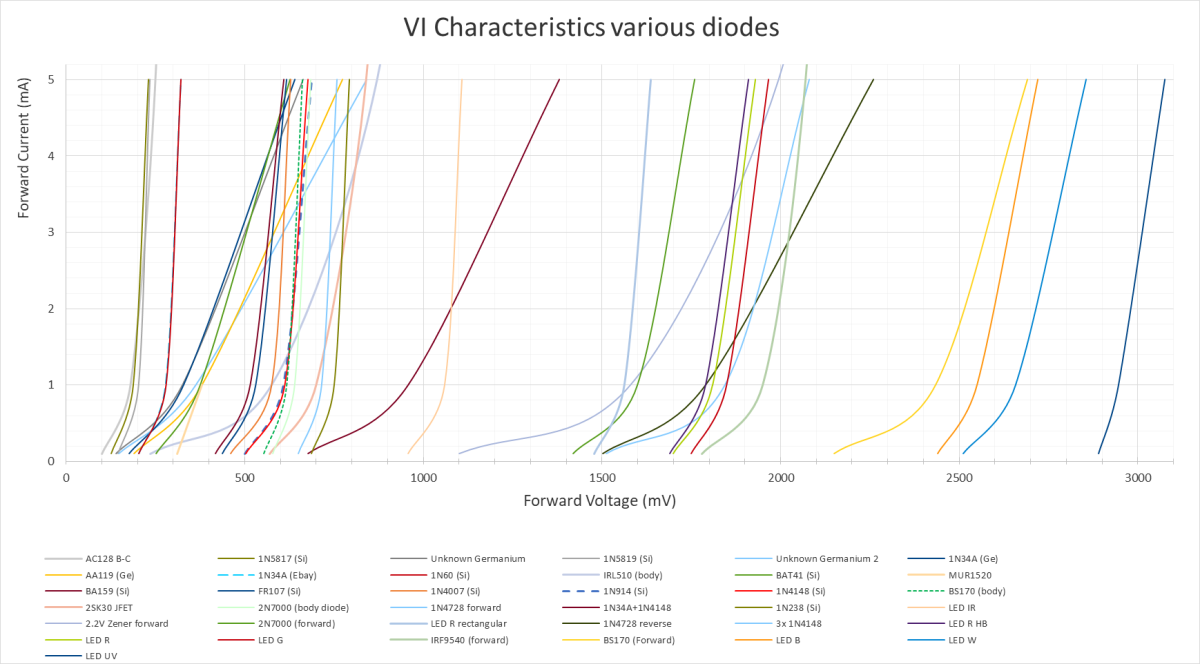PS:
LEDs CLIPPING INFO
http://www.diystompboxes.com/smfforum/index.php?topic=85219.0
| color | voltage (Volts) |
| IR | 1.5 |
| red | 2.0 |
| orange | 2.0 |
| yellow | 2.1 |
| green | 2.2 |
| true green | 3.3 |
| blue | 3.3 |
| white | 3.3 |
| UV | 3.3 |
| blue (430 nm) | 4.6
|
The 5mm diffused red and 5mm diffused green LEDs I have here clip at 1.8V for the red and 2.6V for the green. So the green LEDs are going to give you more headroom on the gain knob enabling you to get more clean boost. I don't think you'll perceive any difference it the tonality of the clipping. When I've compared different color LEDs by ear, they sound pretty much the same once you normalize the gain and volume.
MARK HAMMER ON MULTIPLE LEDs in SERIES
You're getting clipping on one half cycle of the signal, but most likely nothing on the otherhalf cycle...or at least nothing that crops up for more than a few miliseconds here and there. A pair of LEDs in series represents a forward voltage that could easily be in the 3V+ range. A stock TS applies a maximum gain of 118x. Divide our hypothetical 3000mv threshold by 118 and at max gain that half cycle of the signal would need to be at least 25mv (i.e., p-2-p > 50mv) in order to be clipped. Not that many guitar signal remain above that point for very long. True, they CAN produce peaks much greater than that, but those peaks don't really last all that long during the entire lifespan of the picked note.
For reference, the typical 1N914s clip at around 0.7V.
Some other LEDs:
5mm diffused orange 2.0V
5mm diffused yellow 2.1V
5mm clear blue 3.3V
5mm clear white 3.5V
M HAMMER:
The LED colour with the lowest clipping threshold (around 1.5v) is red, and is approximately equal to using three 1N914 diodes in series for each direction [BMPOA!]
. Other colours, because of the different composition, have higher thresholds.
10 :: 5mm RED WATER CLEAR ULTRA BRIGHT :: TAYDA A-706
Manufacturer: LIGITEK
Emitting colour: Red
Diameter: 5mm
Lens colour: Water Clear
Forward voltage(V): 2.0-2.2
Current(mA): 20
View angle: 25
Luminous intensity(MCD): 8,000 - 12,000
10 :: 5mm BLUE WATER CLEAR ULTRA BRIGHT :: TAYDA A-407
Manufacturer: LITE-ON
Emitting color: Blue
Diameter: 5mm
Lens color: Water clear
Forward Voltage(V): 3.2-3.4
Current(MA): 20
View angle: 20
Luminous intensity(MCD): 12,000 - 14,000
10 :: 5mm WHITE WATER CLEAR ULTRA BRIGHT :: TAYDA A-408
Manufacturer: LITE-ON
Emitting color: White
Diameter: 5mm
Lens color: Water clear
Forward Voltage(V): 3.2-3.4
Current(MA): 20
View angle: 25
Luminous intensity(MCD): 16,000 - 20,000
5 :: 5mm YELLOW :: TAYDA A-1555
Manufacturer: LIGITEK
Emitting color: Yellow
Diameter: 5mm
Lens color: Yellow Diffuse
Forward voltage(V): 2.0-2.3
Current(mA): 20
Luminous intensity(MCD): 2,000 - 3,000
5 :: 5mm GREEN WATER CLEAR SUPER BRIGHT :: TAYDA A-057
Manufacturer: LIGITEK
Emitting color: Green
Diameter: 5mm
Lens color: Water Clear
Forward voltage(V): 3.2-3.4
Current(mA): 20
View angle: 30
Luminous intensity(MCD): 8,000 - 10,000
5 :: 5mm GREEN :: TAYDA A-1553
Manufacturer: LIGITEK
Emitting color: GREEN
Diameter: 5mm
Lens color: Green Diffuse
Forward voltage(V): 2.3-2.5
Current(mA): 20
Luminous intensity(MCD): 2,000 - 3,000
20 :: 3mm RED SUPER BRIGHT :: TAYDA AZ-1554
Manufacturer: KENTO
Manufacturer Part No: 5408URC
Illumination Colour: Red
Lens Colour/Style: Red
LED Size: 5mm
Lens Shape: Round
Wavelength/Color Temperature: 620-630nm
Luminous Intensity: 8000 - 10000 mcd
Viewing Angle: 30 deg
Forward Voltage: 1.9 - 2.1 V
Forward Current: 20mA
Maximum Operating Temperature: + 100 C
Minimum Operating Temperature: - 20 C
20 :: 3mm RED :: TAYDA A-261
Manufacturer: LIGITEK
Emitting color:Red
Diameter:3mm
Lens color: Red Diffuse
Forward voltage(V):2.0-2.2
Current(MA):20
Luminous intensity(MCD): 4,000 - 6,000
20 :: 3mm RED WATER CLEAR ULTRA BRIGHT :: TAYDA A-705
Manufacturer: LIGITEK
Emitting color: Red
Diameter: 3mm
Lens color:Water Clear
Forward voltage(V): 2.0-2.2
Current(mA): 20
View angle: 20 - 25
Luminous intensity(MCD): 4,000 - 6,000
10 :: 3mm GREEN :: TAYDA A-262
Manufacturer: LIGITEK
Emitting color: GREEN
Diameter: 3mm
Lens color: Green Diffuse
Forward voltage(V): 2.3-2.5
Current(mA): 20
Luminous intensity(MCD): 2,000 - 3,000
5 :: 3mm YELLOW :: TAYDA A-263
Manufacturer: LIGITEK
Emitting color: Yellow
Diameter: 3mm
Lens color: Yellow Diffuse
Forward voltage(V): 2.0-2.3
Current(mA): 20
Luminous intensity(MCD): 2,000 - 3,000
10 :: 3mm BLUE WATER CLEAR ULTRA BRIGHT :: TAYDA A-406
Manufacturer: LITE-ON
Emitting color: Blue
Diameter: 3mm
Lens color: Water clear
Usage voltage(V): 3.2-3.4
Current(MA): 20
View angle: 20 - 25
Luminous intensity(MCD): 18,000
10 :: 3mm GREEN WATER CLEAR SUPER BRIGHT :: TAYDA A-064
Manufacturer: LIGITEK
Emitting color: Green
Diameter: 3mm
Lens color:Water Clear
Wavelength: 515 - 520 nm
Forward voltage(V): 3.2 - 3.4 V
Current(mA): 20
View angle: 20 - 25
Luminous intensity(MCD): 10000 - 12000 mcd
10 :: 3mm WHITE WATER CLEAR ULTRA BRIGHT :: TAYDA A-2226
Manufacturer: LIGITEK
Emitting color: White
Diameter: 3mm
Lens color: Water clear
Forward Voltage(V): 3.2-3.4
Current(MA): 20
View angle: 25
Luminous intensity(MCD): 14,000 - 16,000
10 :: 3MM ORANGE WATER CLEAR :: TAYDA A-4571
Manufacturer: LIGITEK
Emitting color:Orange
Diameter:3mm
Lens color: Water Clear
Forward voltage(V):1.8-2.0
Current(MA):20
Luminous intensity(MCD): 4,000 - 6,000
10 :: 3mm ORANGE :: TAYDA A-264
Manufacturer: LIGITEK
Emitting color: Orange
Diameter: 3mm
Lens color: Orange Diffuse
Forward voltage(V): 2.0-2.3
Current(mA): 20
Luminous intensity(MCD): 2,000 - 3,000
5 :: 3mm RED :: WECL L10 13-01-0201
10 :: 3mm GREEN :: WECL L11 13-01-0202
5 :: 3mm YELLOW :: WECL L12 13-01-0203
